When choosing the right beach umbrella size, consider your group size and planned activities. Smaller umbrellas (about 5 feet) are portable and ideal for solo outings, while larger ones (7-9 feet) provide more shade for families or groups. Think about portability, setup ease, and weather conditions like wind and sun intensity. By considering these factors, you’ll find the perfect fit for comfort and protection—more helpful tips are just ahead.
Key Takeaways
- Match umbrella size to your group size and planned activities for adequate shade and comfort.
- Consider portability, setup ease, and weather resistance to ensure practical use at the beach.
- Larger umbrellas (7-9 ft) provide more coverage but may be heavier; smaller ones are lightweight and portable.
- Evaluate UV protection features and canopy durability to stay safe and comfortable in various conditions.
- Use size standards and detailed guides to compare options and select an umbrella that fits your space and needs.
Understanding Different Beach Umbrella Sizes and Dimensions
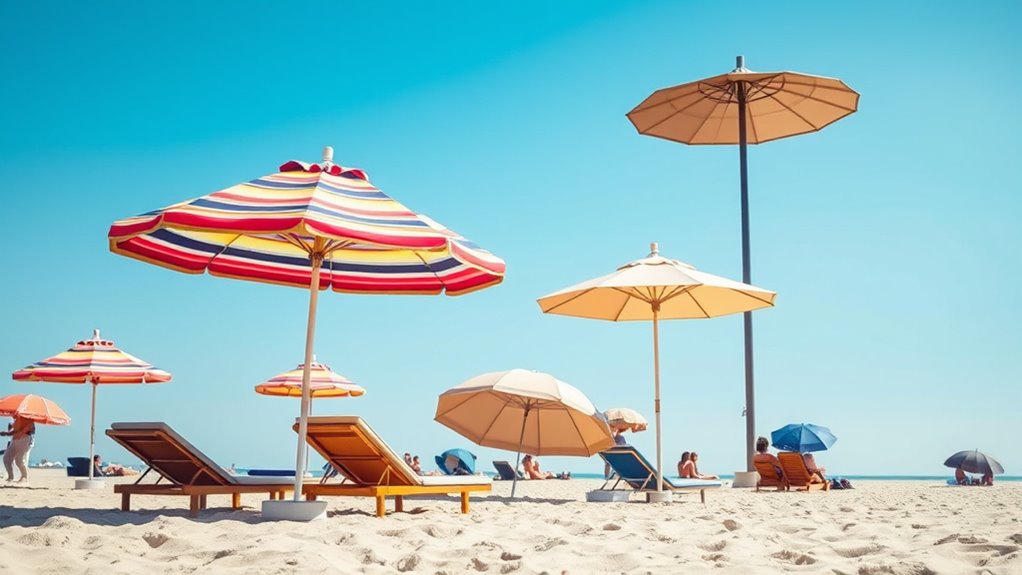
Understanding the different sizes and dimensions of beach umbrellas is essential for choosing the right one for your needs. Beach umbrellas typically range from small to large, with diameters from about 5 to 9 feet. Smaller umbrellas, around 5 feet, are lightweight and easy to transport, ideal for solo use or small setups. Larger umbrellas, 7 to 9 feet, provide more shade and are better suited for families or groups. Consider the pole height and canopy diameter, as these influence how much shade you’ll get and how comfortably you can move underneath. Keep in mind that larger umbrellas may be heavier and more cumbersome to carry, but they offer better coverage. Additionally, understanding umbrella dimensions can help you select the most suitable size for your specific needs and space constraints. Being aware of the support hours of nearby parks or beaches can also help you plan your visit for optimal shade and enjoyment. For optimal comfort, also consider the wind resistance of different umbrella sizes, especially in breezy beach environments. Analyzing drift and wind patterns can help you choose a more stable and secure umbrella setup. Considering additional features, such as tilt mechanisms or vented canopies, can further enhance your comfort and protection against the elements.
Considering Your Group Size and Activity Needs
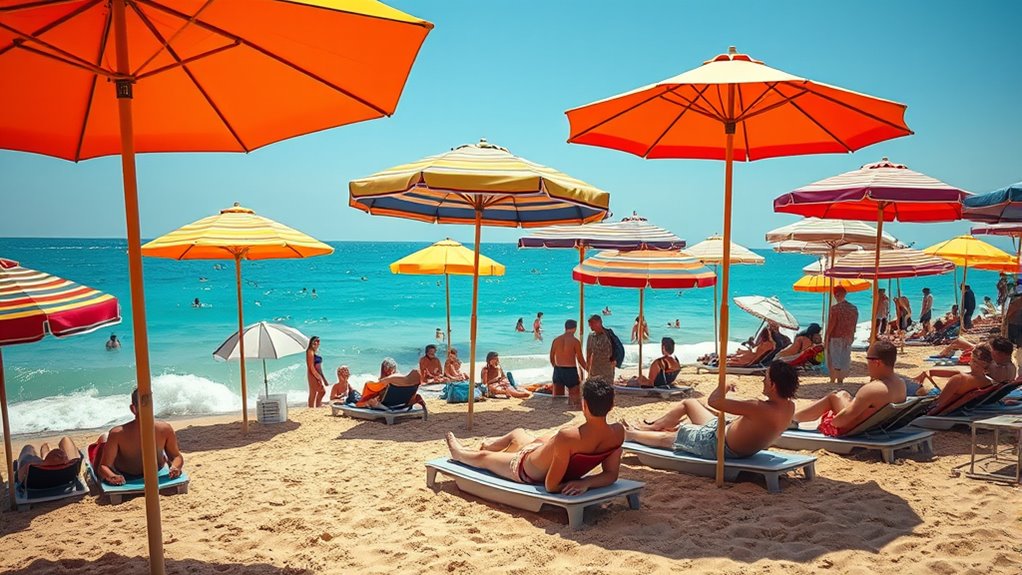
When selecting a beach umbrella, consider how many people will use it and what activities you’ll be doing. If you’re planning a small family or a couple of friends, a compact umbrella may suffice, providing enough shade without bulk. For larger groups, opt for a bigger umbrella to guarantee everyone stays protected from the sun. Think about activities like lounging, reading, or playing games—if you’ll be moving around or hosting multiple activities, a larger, more stable umbrella can accommodate these needs. Also, consider if you’ll need space for beach gear, chairs, or a cooler underneath. Matching your umbrella size to your group size and planned activities ensures everyone stays comfortable and protected all day long. Additionally, understanding offensive security measures can help you choose an umbrella with features like wind resistance to prevent damage during strong gusts. Incorporating risk management strategies can also extend the lifespan of your beach umbrella by protecting it from unexpected weather conditions. For example, selecting an umbrella with UV protection features can provide extra safety from harmful sun rays. Moreover, considering seasonal influences can help you select a material and color that suits the current weather and enhances durability. Proper anchoring and wind-resistant design are also crucial to keep the umbrella stable during storms or gusty days, ensuring safety and longevity.
Evaluating Portability and Ease of Setup
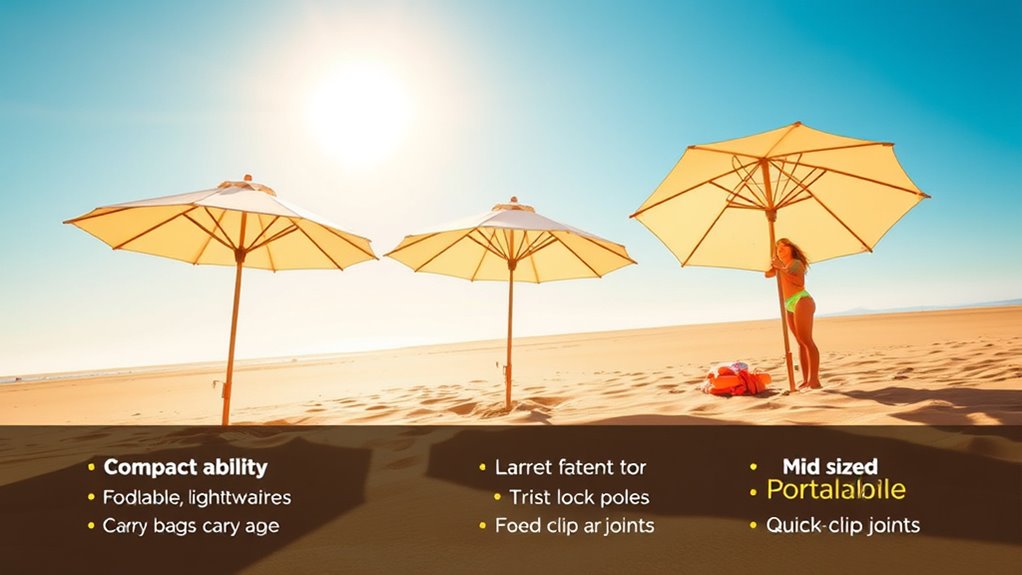
After determining the right size for your beach umbrella, it’s important to think about how easy it is to carry and set up. Portability impacts how smoothly your day unfolds. Look for lightweight materials and manageable weight, especially if you’ll be walking long distances. Consider whether the umbrella features a quick-setup mechanism to save time and effort. A sturdy carrying case can make transportation easier. Additionally, selecting an umbrella with tuning features such as adjustable height or flexible setup options can enhance convenience. Be mindful of family photoshoot fails, as unplanned weather or pet antics can occur unexpectedly, so a portable and easy-to-setup umbrella can help you adapt quickly. Properly assessing the waterproofing and durability of the umbrella can also prevent mishaps during sudden rain showers, and choosing models with UV protection can further safeguard your skin during sunny days. Understanding the merchant services landscape can help you select products that offer the best value and security for your outdoor needs.
Analyzing Weather Conditions and Sun Coverage
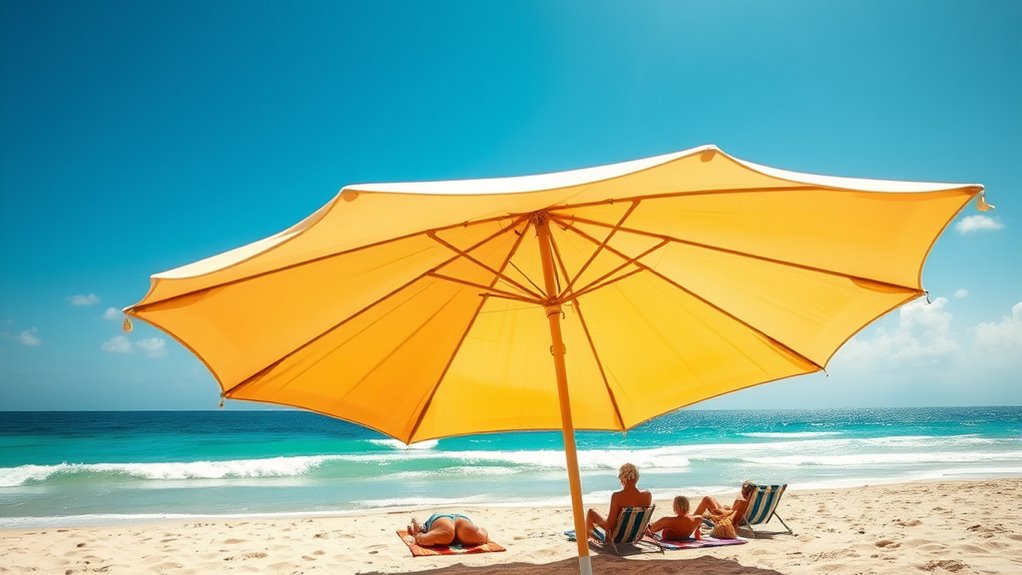
Evaluating the weather conditions before heading to the beach guarantees you choose the right umbrella for sun protection. Check the forecast for UV index, wind speed, and cloud cover. A high UV index means you need more shade, so opt for a larger umbrella with ample coverage. Strong winds require a sturdy, wind-resistant model or a lower profile umbrella to prevent tipping. Cloud cover can reduce sun exposure but doesn’t eliminate UV rays, so consider how much direct sunlight you’ll encounter. If the forecast predicts intense sun and little cloud cover, a larger umbrella with a broad canopy ensures maximum protection. Conversely, on overcast days, a smaller umbrella might suffice. Always plan based on the specific weather conditions to stay comfortable and safe. Being aware of weather-related factors can help you select the most suitable umbrella size and type for your beach day. Additionally, understanding cooking techniques can be beneficial for preparing snacks or meals to enjoy during your outing. Incorporating knowledge of nutritional content can also help in choosing healthy snacks to keep your energy up while relaxing outdoors. Considering UV protection features when selecting an umbrella can further enhance your sun safety measures.
Tips for Selecting the Perfect Fit for Your Beach Experience
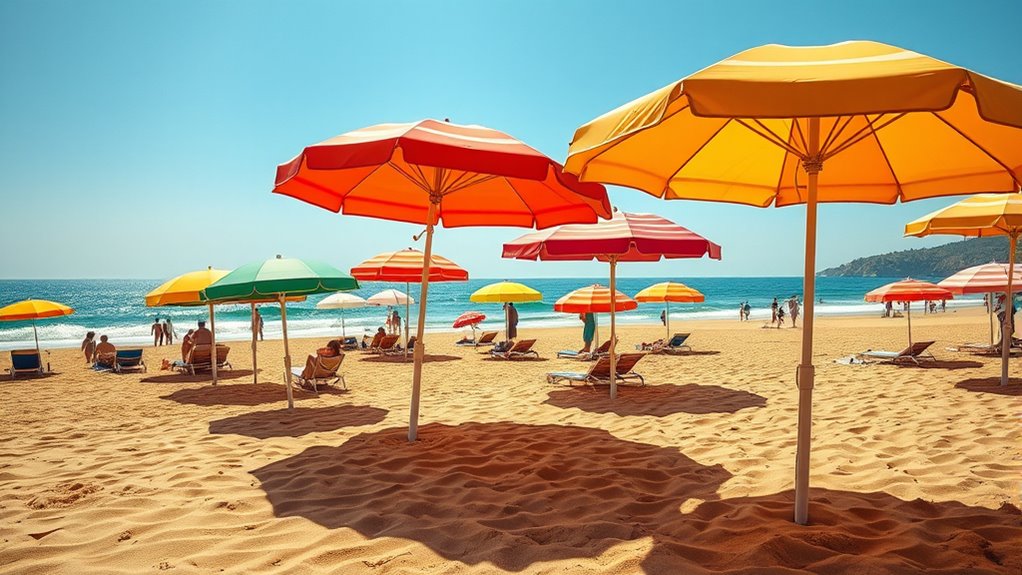
Choosing the right size beach umbrella isn’t just about weather; it’s about making sure you’re comfortable and well-protected throughout your stay. Consider how many people will be under the umbrella—if you’re with family or friends, a larger size provides ample shade for everyone. Think about your activities too; if you plan to lounge, read, or relax, a bigger umbrella can create a cozy, shaded retreat. On the other hand, if you’re looking for something portable or easy to set up, a smaller umbrella might be better. Also, pay attention to your spot’s layout—ensure the umbrella fits comfortably without blocking pathways or crowding others. Ultimately, pick a size that balances coverage, portability, and your personal comfort for a perfect beach day. Additionally, selecting an umbrella with a high-quality canopy material can improve durability and UV protection during your outing. Considering UV protection features when choosing your umbrella can further ensure you stay shielded from harmful rays while enjoying the sun. Being aware of umbrella size standards can help you make a more informed decision and find the best fit for your beach needs. Moreover, understanding lifestyle considerations like your typical beach activities can guide you toward the most suitable umbrella size for your unique needs.
Frequently Asked Questions
How Do I Maintain My Beach Umbrella for Longevity?
To keep your beach umbrella lasting longer, you should regularly clean it with mild soap and water to prevent dirt buildup. Always close and store it in a dry, shaded area when not in use to avoid sun damage and rust. Check the fabric for tears and repair promptly. Additionally, tighten any loose screws or joints to maintain stability. Proper maintenance guarantees your umbrella stays sturdy and vibrant for many beach days.
Are There Eco-Friendly Beach Umbrella Options Available?
Are eco-friendly beach umbrellas truly available? Absolutely! You can choose options made from sustainable materials like recycled fabrics, bamboo, or responsibly sourced wood. Many brands now prioritize eco-conscious manufacturing, reducing environmental impact. By selecting these, you’re not only protecting yourself from the sun but also helping to preserve our planet. Isn’t it rewarding to enjoy the beach while making a positive difference? Opt for eco-friendly umbrellas and enjoy both style and sustainability.
Can I Use a Regular Umbrella as a Beach Umbrella?
You can use a regular umbrella as a beach umbrella, but it’s not ideal. Regular umbrellas aren’t designed to withstand wind, sun, or saltwater, making them fragile and less effective for beach conditions. They lack the UV protection, waterproof material, and sturdy frame needed. If you opt for a regular umbrella, be prepared for potential damage and limited sun protection. It’s better to choose a beach-specific umbrella for comfort and durability.
What Safety Precautions Should I Take With Large Umbrellas?
When using large umbrellas, you should always secure them properly to prevent accidents. Make sure the umbrella is anchored firmly in the sand or ground, especially on windy days. Keep an eye on weather conditions and close the umbrella if strong winds pick up. Avoid placing the umbrella near walkways or areas with high foot traffic to prevent it from tipping over or causing injuries. Staying vigilant keeps everyone safe.
How Do I Choose a Beach Umbrella for Windy Conditions?
Did you know that wind causes over 60% of beach umbrella accidents? To choose a beach umbrella for windy conditions, look for one with a sturdy, vented canopy to allow airflow and reduce risk of tipping. Opt for a heavy base or sandbag weights to anchor it securely. Always close and secure the umbrella when not in use or during strong gusts to prevent accidents and guarantee safety on windy days.
Conclusion
Choosing the right beach umbrella isn’t just about size; it’s about creating your perfect sun sanctuary. Think of it as finding the key to your ideal beach day—a small gesture that grants comfort and shade amidst the sun’s glare. By considering your group, activity, and weather, you guarantee every moment is spent relaxing, not squinting. So, pick wisely, and let your beach umbrella be the hero of your seaside story.










